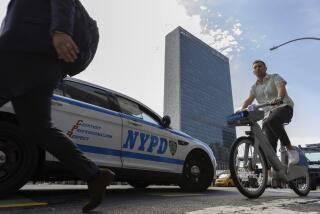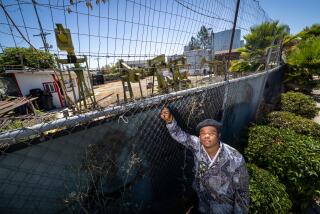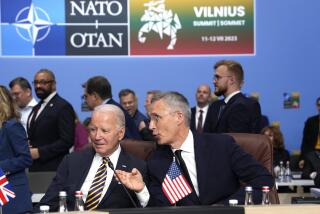Protesters Turn Genoa to War Zone
GENOA, Italy — Two worlds collided Friday on what is becoming one of the 21st century’s great battlegrounds as tens of thousands of protesters from as far as Canada, Ireland and Pakistan marched to protest the global development strategy being charted here by the world’s wealthiest countries.
Areas of Genoa looked like urban war zones after the initially peaceful protests broke down into riotous confrontations. Small groups of self-described anarchists clad in black torched cars and smashed businesses as larger columns of organized protesters marched on the barricades protecting the port area where leaders of the Group of 8 industrialized nations opened a three-day summit.
The conflict crossed an ominous threshold with the death of one demonstrator--the first fatality in the wave of protests challenging the morality and standards of globalization that was launched at the December 1999 World Trade Organization summit in Seattle.
Genoa, hosting President Bush at his first G-8 summit, also is witnessing the largest protest ever staged against the pattern and pace of global change. The crowds that besieged the Summit of the Americas in Quebec City and the U.S.-European Union summit in Goteborg, Sweden, earlier this year were smaller than the estimated 60,000 people who have turned up here so far.
Passions have been running deeper too. Orla Judge, a 21-year-old British student with bloodied clothes, two sets of bandages in her short blond hair and the phone numbers of legal aid services inked across her forearm, was among the injured. She was also in Goteborg last month.
“The leaders are not listening to us,” she said. “The fences are just getting higher at every summit. The G-8 says it is trying to include and help people, but these fences only cut off the people. They’re not democratic. And being hit on the head for daring to say that I don’t like what the G-8 is doing is not democratic either.”
Judge was injured when she and other young people tried to push in the 13-foot-high barrier of concrete-lined iron grating with their bare hands to get into the “red zone” where the leaders were meeting. Security forces used water cannons, pepper spray and tear gas to scatter them before charging with batons.
Another group of protesters ended up near Piazza Dante, a few blocks from the Ducal Palace where the G-8 leaders were meeting. They raised a deafening ruckus by rubbing bottles against the security fence and chanting slogans as a small group of musicians jammed discordant music on the saxophone, flute, clarinet and drums.
Tensions escalated when protesters began lobbing water bottles, food and water-filled balloons over the fence at riot police, who were deployed in three tiers: in armored cars and vans at the front, behind shields and riot gear several yards back, and on horseback in the rear.
Police reinforced the 2.5-mile-long red zone perimeter with outer walls of shipping containers and wooden barriers. While some protesters reached the inner ring of iron grating, police moved half a mile east from the red zone to stop one of the largest, most aggressive columns moving toward it.
Bush and his counterparts--the leaders of Britain, Canada, France, Germany, Italy, Japan and Russia--never saw or heard the protests.
The issue that has moved people from across three continents to travel here is not whether to globalize, but how to do it in ways that will not leave the majority of people behind.
The protesters are demanding global justice on a wide range of issues, from debt relief for developing nations to lower barriers against immigration from poorer to richer countries.
But while such demands are gaining popular support in the West, the broad movement has had to contend with criticism that its summit-hopping protests are routinely marred by internal divisions and violence that detract from its causes.
Friday’s violence was a case in point--a struggle for terrain not only between police and demonstrators, but among diverse factions of the anti-G-8 forces.
There was a “pink” pacifist bloc that did not seek to confront the police at all and a “yellow” civil disobedience bloc of protesters who tried to breach the summit’s red zone with its members’ bodies but without clubs or other weapons. The Genoa Social Forum, the overall protest organizer, persuaded both blocs to stay out of each other’s way and refrain from attacking anything except the security barrier.
But there was also a “black” bloc, hundreds of anarchists, most wearing black face masks, who reject the Forum’s authority and rules.
The trouble started about 12:30 p.m. when more than 100 anarchists fell into a larger march by Cobas, an Italian trade union in the pink bloc, near Piazza Tommaseo, about half a mile east of the red zone.
The anarchists started smashing bank windows. The unionists yelled at them to stop, prompting the anarchists to attack the unionists.
The anarchists were Basques, Germans, Austrians, English and others. “They were like a tower of Babel,” said Jose Miguel Morales, a 31-year-old meteorologist from Spain. “They even fought among themselves.”
Moving a few blocks north, the anarchists smashed up a German rental car office while the clerk on duty, Barbara Tacopucci, 25, cowered in the bathroom. They took the keys to a gray Fiat Bravo, unlocked it and set it afire. A block away, they forced a woman to abandon her car and torched it too.
The burning cars sent black smoke pouring into Via Tolemaide, part of the route of an authorized march by the yellow bloc, and drew riot police to the area.
Two miles farther east, the 3,000-strong yellow bloc was just assembling at its soggy campground for the procession, vowing to break into the G-8 area. It was this march, led by the militant leftist White Overalls group and joined by socialists from all over Europe, that had attracted most of the pre-summit attention.
After months of preparation, many protesters thought they were well equipped for the clash to come. Many wore shinguards, bicycle helmets and gas masks. By 12:45 p.m. they were marching toward the summit in a festive mood.
An hour later, the mood changed and the march stopped. Organizers did not want to move past the smoking car hulks until the anarchists left the area. Federico Mariani, one of the march leaders, berated TV crews for filming the destruction.
“This is not what the protest is about!” he shouted.
At 2:30 p.m., Mariani gave the go-ahead. Four giant plexiglass shields were placed side by side across the road on rollers, in front of the first row of marchers, who resumed the procession.
The strange spectacle of the rolling shields did not last long. It reached the corner of Tolemaide and Corso Torino, where at 3 p.m. a full-scale riot erupted, started by the Carabinieri, blue-clad military police.
Behind shields and gas masks superior to those of the marchers, the police moved against the crowd without warning, firing tear gas. As row after row of Carabinieri poured into Via Tolemaide, anarchists who had infiltrated the yellow bloc broke from the marchers and spilled into side streets for a melee that lasted into evening.
One police van went up in flames during a see-saw battle with rocks and firebombs. It was on one of those side streets near Piazza Alimonda that a protester was killed. Italy’s top police official said he was shot, apparently by officers acting in self-defense, but witnesses differed on whether he was shot, beaten or run over by a police vehicle.
The huge shields fell away.
Some anarchists climbed onto a highway bridge above the marchers and threw rocks at the police. Most of the rocks fell on the marchers’ heads. By 4:30 p.m. the marchers were in retreat, walking dejectedly back to their camp through streets of broken glass and discarded body padding.
It was a humiliating moment for leaders of the organized protest, who felt confident that their numbers could isolate troublemakers.
More to Read
Sign up for Essential California
The most important California stories and recommendations in your inbox every morning.
You may occasionally receive promotional content from the Los Angeles Times.










